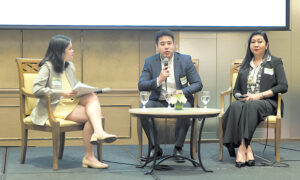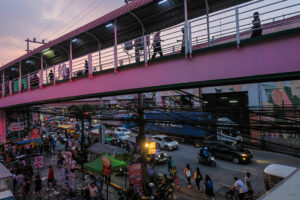
Future-proofing communities through sustainable developments

By Mhicole A. Moral, Special Features and Content Writer
About 49% of Filipinos now live in urban barangays, and roughly 36% of them stay in informal settlements, according to the United Nations. Many of these residents lack access to clean water, stable electricity, and proper sanitation — problems that expose the weaknesses of rapid urbanization.
The importance of sustainable urban development was discussed at the BusinessWorld Insights forum on Oct. 3 at Dusit Thani Manila. The event, themed “Building Smart, Sustainable, and Future-Ready Communities,” gathered experts to discuss how cities can prepare for the next phase of urban growth.
United Nations Development Programme (UNDP) Philippine Economist Mohamed Shahudh said cities are reaching their limits as populations rise faster than infrastructure can keep up with.
“When rapid urbanization takes place, these historic infrastructures are pushed beyond what they were designed to handle,” Mr. Shahudh said. “Climate change makes things worse, exposing these cities to higher levels of risk.”
UNDP data show that urban areas worldwide need between $4.5 trillion and $5.4 trillion each year until 2030 to modernize housing, transport, energy, water, and waste management systems. However, from 2001 to 2022, cities received less than 20% of the funding required for infrastructure.

Mr. Shahudh noted that the Philippines is lagging in achieving the Sustainable Development Goal 11 on sustainable cities. For him, the country should build sustainable communities by involving three key areas: climate adaptation, circular economy practices, and stronger local governance.
“Approaches must be people-centered, especially for the vulnerable,” he said. “Adaptation plans should be co-created with urban communities, and nature-based solutions must be mainstreamed as they are among the most cost-effective and resilient responses.”
Mr. Shahudh added that empowering local authorities is essential to strengthening urban resilience. Some local governments are already making progress through programs targeting plastic pollution, food waste, and water management.
“The choices that are made today will decide whether cities of tomorrow are vulnerable, fragmented, or truly sustainable,” Mr. Shahudh said. “Local action will remain the fundamental building block of future resilient cities.”
Sustainability as shared responsibility
Industry leaders believe sustainability is not only a government duty but a shared responsibility among all sectors.
Ramon Rivero, chief strategist and sustainability lead of Robinsons Land Corp. (RLC), said true progress can happen only when people work together toward a common goal.
“There are three key players in making sure sustainability is protected: the public sector, the private sector, and the community,” Mr. Rivero said. “The intersection of those three is where we can all thrive together.”
He said cooperation between businesses and regulators helps align local practices with international sustainability standards. RLC, for instance, works closely with the Securities and Exchange Commission to promote environmental, social, and governance (ESG) programs.
“There’s a stereotype that ESG is expensive. But sustainability does not sacrifice profit — it protects it,” he explained. “For the longest time, profit has been the common language in business. But now we must also track carbon emissions, foot traffic, and walkability as indicators of long-term value.”
He added that providing stronger incentives, such as tax breaks for companies that adopt sustainable measures, would encourage more participation from the private sector. However, the idea of sustainability should not stop at company policies or government programs.
“Even individuals can make a difference,” he said. “We can set up systems that make sustainability easy rather than difficult. Small habits, like observing Earth Hour, help build a culture of responsibility.”
Meanwhile, Cathy Saldaña, chief executive officer and principal of pdp + Architecture, said sustainability must be present in every phase of development, from planning to construction.
“Sustainability and community building are responsibilities not just for developers or architects and planners like us, but for everybody,” Ar. Saldaña said. “No matter what sector you are in, sustainability is our responsibility.”
Ar. Saldaña said good design respects the identity of each location instead of copying the look of big cities.
“You do not bring Manila into Palawan or Boracay,” she said. “Each area has a unique carrying capacity, and we must respect that.”
In terms of renewable energy, Ar. Saldaña said rural and island communities are starting to adopt flexible systems that combine traditional power with renewable. She noted that the National Electrification Administration has been supporting hybrid or multi-grid systems.
Solving water shortage

The forum also tackled further water sustainability, as Vivant Water President and Chief Executive Officer Atty. Jess Anthony Garcia noted in his presentation that Cebu is running short of clean water, with supply meeting only about half of its daily demand.
As a result, only 35% of Cebu households have consistent water service, compared to more than 95% in Metro Manila.
“We are short by about 250 million liters a day,” Atty. Garcia said. “And that figure does not even include the suppressed demand — those who stopped asking for connections because they know water will not be available.”
He said Cebu’s geography makes the problem more difficult. The island is long, narrow, and mountainous, which limits the formation of large rivers or catchment areas. Its limestone terrain also absorbs water easily, preventing groundwater storage.
“When you overdraw groundwater or when septic systems leak into aquifers, you lose that supply permanently,” he said. “Cebu’s economic growth has only made that worse.”
Atty. Garcia noted that many people assume the planet has abundant water because 71% of Earth’s surface is covered by it, but 97.5% is saltwater. Of the remaining 2.5% that is fresh, less than 1% is accessible for human use.
That small fraction is shared among households, farms, and industries worldwide. Rising populations and expanding cities have placed more pressure on limited resources, while climate change worsens the problem by drying up reservoirs and altering rainfall patterns.
To help address the shortage, Vivant Water is completing the country’s first large-scale seawater desalination plant in Cordova, Cebu. The Isla Mactan-Cordova Corp. (IMCC) facility, located along the Hinutungan Channel, will use seawater reverse osmosis technology to produce 20 million liters of potable water daily.
The process involves drawing seawater through filters to remove debris and microorganisms before it passes through high-pressure membranes. At about 750 psi, the membranes separate salt and minerals from clean water. The plant then adds back essential minerals and uses an energy recovery system to reuse excess pressure, reducing power use.
He acknowledged that desalination can be expensive but it remains cheaper and more reliable than most alternatives. In Cebu, piped water costs about P35 per cubic meter but often runs dry. Trucked or bottled water can range from P150 to P2,500 per cubic meter. The desalinated water, at about P75 per cubic meter, offers a steady and affordable option.
“It is still the most cost-effective way to secure reliable supply,” he said. “We must also recognize that sustainability means paying the true cost of water — not too much, but fair enough to keep systems running and investors committed.”
Atty. Garcia stressed that desalination should not be seen as the only solution. He urged both government and private groups to explore other sources such as rainwater harvesting, aquifer restoration, wastewater recycling, and a proposed plan to transport water from nearby Bohol.
“Desalination must be part of a broader strategy. We need a mix of methods that make water affordable, reliable, and sustainable,” he said. “We aim to create a future where children will not have to worry about turning on the tap and finding nothing.”



